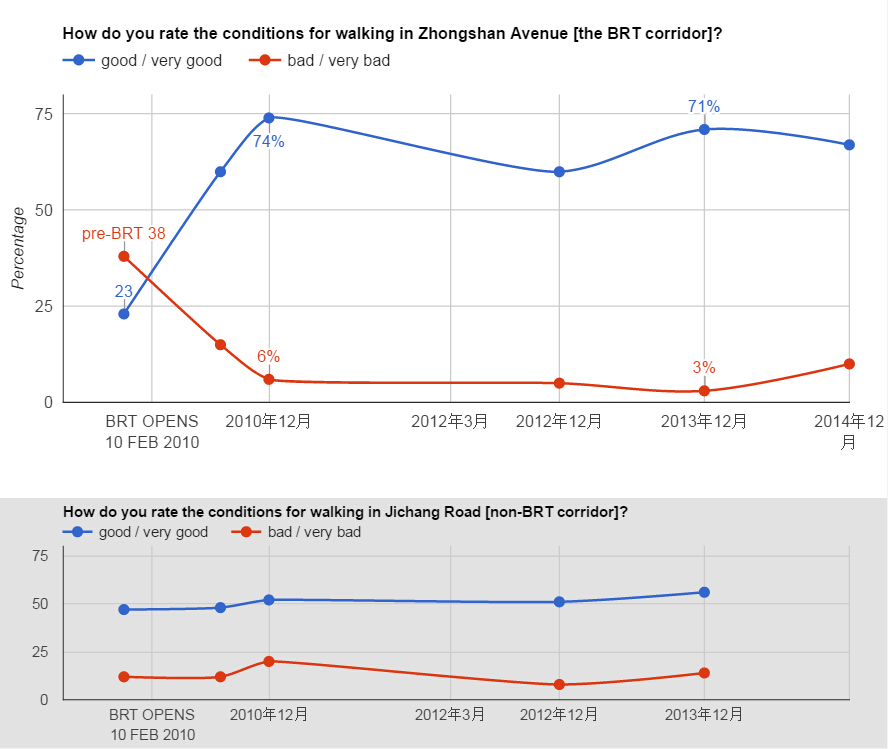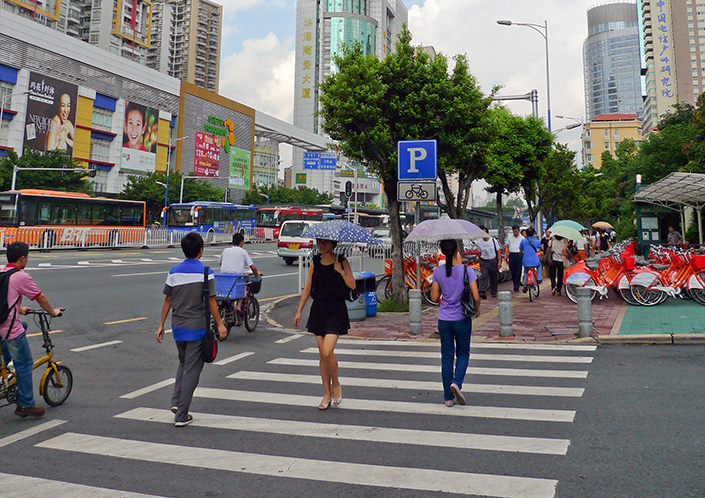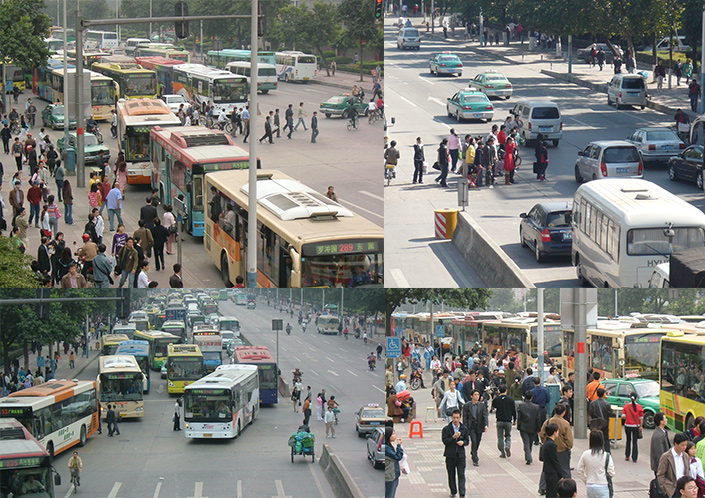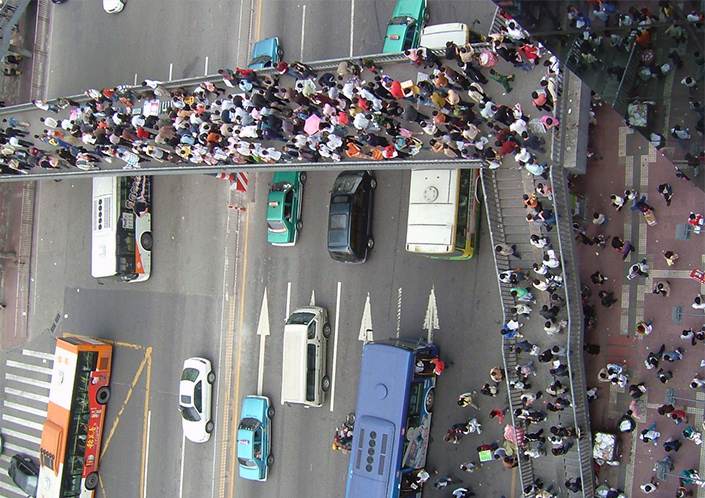Institute for Transportation and Development Policy
Promoting sustainable and equitable transportation worldwide
Pedestrian perceptions reversed in Guangzhou BRT corridor.
Satisfaction rises from 23% to 74%; dissatisfaction falls from 38% to 6%
15 April 2014 [updated with December 2014 survey results]
Question to pedestrians:

A key part of BRT corridor design should be to try to ensure high quality bike facilities along the BRT corridor, making cycling a more attractive option. Despite numerous issues with bike lane connectivity, especially across intersections, a dramatic transformation of perceptions of the quality of the cycling environment along the Guangzhou BRT corridor has been achieved. ITDP's impact analysis surveys related to the Guangzhou BRT system included interviews of cyclists along the BRT corridor as well as in a non-BRT corridor, for comparative purposes. Surveys were carried out before the BRT and at least once each year since it opened in February 2010.
Bicycle facilities included in the BRT planning and design included a bike sharing system, bike parking facilities, and segregated bike lanes (though these are not continuous in many locations). The result has been both a large increase in cycling (bike volumes have doubled during the morning and evening peak periods at Tangxia, between December 2009 and January 2014) as well as huge improvements in the perceived quality of bicycle facilities.
Before the Zhongshan Avenue BRT opened, 47% of cyclists in Zhongshan Avenue either 'disagreed' or 'strongly disagreed' with the statement that 'the quality of bike facilities on Zhongshan Avenue is good'. Only 15% of cyclists agreed. After the BRT opened, those agreeing or strongly agreeing that bicycle facilities along the BRT corridor are good has increased to 78%, while those disagreeing has fallen to 5%. Thus satisfaction rates with bicycle facilities soared from 15% to 78%, and dissatisfaction plunged from 47% to 5%. On the non-BRT corridor surveyed for comparative purposes, satisfaction with bicycle facilities also improved over the period, though by a much smaller margin, from 32% to 52%. Rates of dissatisfaction in the non-BRT corridor were essentially unchanged over the same period. Dissatisfaction rates with bike facilities in the BRT corridor were twice as high as the non-BRT corridor before the BRT opened, and are now four times lower.
Respondents were asked about their perceptions of safety riding a bike on the two corridors. Before the BRT in Zhongshan Avenue was implemented, less than a quarter (24%) of cyclists in Zhongshan Avenue either 'agreed' or 'strongly agreed' with the statement that 'I feel safe riding my bike along Zhongshan Avenue'. More than half (51%) either 'disagreed' or 'strongly disagree' with the statement. After the BRT was implemented these positions were emphatically reversed. More than half (56%) now 'agree' or 'strongly agree', and only 14% either 'disagree' or 'strongly disagree'. Satisfaction rates have more than doubled, while dissatisfaction rates have fallen by more than two-thirds. Meanwhile in the control corridor rates have remained roughly constant over the same period.
Bike parking facilities were also dramatically improved with the Guangzhou BRT, with bike parking facilities included in the design of many of the BRT stations. These improvements are reflected in the great improvements in perceptions of cyclists toward bike parking along the BRT corridor. Those 'agreeing' or 'strongly agreeing' that 'it is easy to find a place to park my bike on Zhongshan Avenue' increased from less than a quarter (24%) before the BRT to two-thirds (66%) after the BRT. Those who 'disagreed' or 'strongly disagreed' with this statement plunged from half (50%) before the BRT to around one-tenth (12%) after the BRT. In the non-BRT corridor the rates have remained roughly constant over the same period, with 40% 'disagreeing' or 'strongly disagreeing' that they can easily find a place to park a bike, and only around one-quarter (23%) either 'agreeing' or 'strongly agreeing'.
Perceptions of the security of bike parking facilities followed a broadly similar pattern, with rates fairly constant along the non-BRT corridor and large improvements achieved along the BRT corridor. In Zhongshan Avenue before the BRT, and in the non-BRT corridor, those who 'disagreed' or 'strongly disagreed' that 'I can safely park my bike for a few hours' hovered around half of all respondents, while only around one-fifth 'agreed' or 'strongly agreed'. While rates remained largely unchanged in the non-BRT corridor, in the BRT corridor after the BRT was implemented these rates were reversed. Nearly half 'agreed' or 'strongly agreed' that they could park a bike safely for a few hours, and only one-fifth 'disagreed' or 'strongly disagreed'.
Clearly while there is still scope for much improvement in bike facilities along the BRT corridor, the implementation of the BRT and related bike facilities has had a huge positive effect.

Bike facilities along the BRT corridor include bike lanes and bike sharing, shown here at Huajing Xincheng BRT station.

Double-tier bike parking under the Gangding BRT station bridge, installed as part of the BRT project.
ITDP's BRT impact analysis is ongoing, and now includes a multi-year set of data on a range of topics from before the BRT was implemented and every year during the BRT operation. For the results outlined above, for each sample set interviews were conducted with between 295 and 396 cyclists in the BRT corridor, and between 236 and 295 cyclists in the non-BRT corridor. For information, maps, photos and data on the Guangzhou BRT seewww.worldbrt.net.
ITDP's BRT impact analysis surveys in Guangzhou show a huge improvement in the walking environment since the BRT was implemented. Before the BRT, 38% of pedestrians interviewed along the BRT corridor rated the walking environment as 'bad' or 'very bad'. Only 23% of pedestrians rated the walking environment as 'good' or 'very good'. The BRT opened in February 2010. In the first set of Winter surveys after the BRT opened, in December 2010 (the August 2010 figures are from Summer, when the heat means walking conditions are generally poorer), the numbers had dramatically reversed, with 74% rating walking conditions as 'good' or 'very good' and only 6% rating it as 'bad' or 'very bad'. In subsequent surveys the rate of satisfaction has maintained high levels, with 71% satisfied with the walking environment in December 2013 (67% in December 2014) and only 3% rating it as 'bad' or 'very bad' (10% in December 2014).
Meanwhile in a non-BRT corridor used as a control survey, satisfaction and disatisfaction rates with the walking environment did not change significantly. Before the BRT, pedestrians in the non-BRT corridor were much more satisfied than pedestrians in the (future) BRT corridor, with a satisfaction rate of more than double: 47% in the non-BRT corridor compared to only 23% in the BRT corridor. In the period since the BRT opened satisfaction in the control corridor has increased to 56%, but it is far below the BRT corridor satisfaction rate of 71%.
There a number of likely contributing factors to this result:
- The BRT led to huge improvements in the safety and convenience of crossing the road, since most stations have safe crossings at each end. This is a stark contrast to the situation for pedestrians crossing the road before the BRT, as shown in the photo below.
- Before the BRT many walkways were blocked by people waiting for buses, making it difficult to walk, as seen in the photo below. After BRT, this was no longer a problem, as people wait for buses in the BRT stations in the centre of the roadway.
- The chaotic and congested situation before the BRT meant that the roadway was noisy and unpleasant. After the BRT traffic flow greatly improved, resulting in less honking, less stop-start traffic, and a generally more pleasant environment.
- Station area improvements have been made at several locations along the BRT corridor, including conversion of setback parking into attractive and popular public plazas and small linear parks.
- Land uses have changed along the BRT corridor, and new shops are being installed as the high quality walking environment attracts retail investment. These shops in turn further enhance the activity and appeal of the walking environment.
- The BRT stations are accessed by a combination of bridges, tunnels, and street level crossings. The BRT bridges are much better for pedestrians than the previous footbridges. All are now covered except for one pre-existing bridge, and the main stations include escalators. All of the previous footbridges were demolished and replaced with new BRT bridges, except for one bridge at Huajing Xincheng which has lifts installed and was retrofitted with ramps to access the BRT station. The example of Gangding is shown below.
- The BRT corridor designs incorporated high quality walkways as part of the BRT project, since the walkways were within the design scope of the project. However, the new walkways were already completed at the time of the December 2009 surveys, when dissatisfaction rates were still high, so this does not appear to be the major explanatory factor.

The pedestrian environment at Tangxia along Zhongshan Avenue before the BRT.

The pedestrian environment at Tangxia with the BRT has been greatly improved. Note the covered footbridge with escalators, the lack of conflict with waiting bus passengers, and the street-level BRT station access provided in addition to the bridge.

The footbridge at Gangding before the BRT.

The footbridge for street crossing and BRT station access at Gangding includes cover, 10m in width, and escalators.
ITDP's BRT impact analysis is ongoing, and now includes a multi-year set of data on a range of topics from before the BRT was implemented and every year during the BRT operation. For the results outlined above, between 308 and 417 pedestrians were surveyed along the BRT corridor in each of the periods listed. In the non-BRT control corridor, between 221 and 290 pedestrians were surveyed. For information, maps, photos and data on the Guangzhou BRT seewww.worldbrt.net.